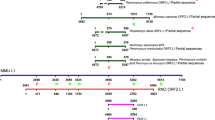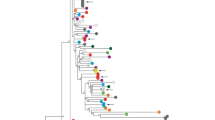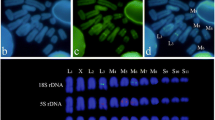Abstract
Chromosomal distribution for two interspersed elements (LINEs andmys) that are thought to have established their chromosomal position primarily by transposition was compared between two species of deer mice (Peromyscus leucopus andP. maniculatus). Both LINEs andmys generally produced an autosomal banding pattern reflective of G-bands and both hybridized preferentially to the sex chromosomes. The pattern on the long arm of the X was unique for each, withmys reflecting the G-bands (four bands with the telomeric most prominent) and LINE producing five equally spaced bands of equal intensity. LINE also preferentially hybridized to the short arm of the longest autosomal pair. Some aspects of these patterns are explained adequately with proposed mechanisms that would produce a non-random pattern of chromosomal distribution (i.e. both reflect autosomal G-bands and both preferentially insert into AT-rich regions characteristic of G-bands). However, other aspects such as the differences observed on the long arm of the X do not appear to fit any predictions of proposed mechanisms.
Similar content being viewed by others
References
Baker RJ, Wichman HA (1990) Retrotransposonmys is concentrated on the sex chromosomes: implications for copy number containment.Evolution 44: 2083–2088.
Baker RJ, Robbins LW, Stangl FB Jr, Birney E (1983) Chromosomal evidence for a major subdivision inPeromyscus leucopus.J Mamm 64: 356–359.
Boyle AL, Ballard SG, Ward DC (1990) Differential distribution of long and short interspersed element sequences in the mouse genome—chromosome karyotyping by fluorescencein situ hybridization.Proc Natl Acad Sci USA 87: 7757–7761.
Committee for Standardization of Chromosomes ofPeromyscus (1977) Standardized karyotype of deer mice,Peromyscus (Rodentia).Cytogenet Cell Genet 19: 38–43.
Fanning TG (1983) Size and structure of the highly repetitive BAM HI element in mice.Nucleic Acids Res 11: 5003–5013.
Furano AV, Somerville CC, Tsichlis PN, D'Ambrosio E (1986) Target sites for the transposition of rat lung interspersed repeated DNA elements (LINEs) are not random.Nucleic Acids Res 14: 3717–3727.
Hattori M, Kuhara S, Takenaka T, Sakaki Y (1986) Sequence analysis of a KPN I family member near the 3′ end of human beta-globin gene.Nucleic Acids Res 13: 2745–2758.
Hutchison CA, Hardies SC, Loeb DDet al. (1989) LINEs and related retroposon: long interspersed repeated sequences in the eucaryotic genome. In Berg DE, Howe MM, eds.Mobile DNA, America Society for Microbiology, Washington, DC, pp 593–617.
Janacek LL, Longmire JL, Wichman HA, Baker RJ (1993) Genome organization of repetitive elements in the rodent,Peromyscus leucopus.Mammalian Genome 4: 374–381.
Kass DH, Berger FG, Dawson WD (1992) The evolution of coexisting highly divergent LINE-1 subfamilies within the rodent genusPeromyscus.J Mol Evol 33: 472–485.
Korenberg JR, Rykowski MC (1988) Human genome organization: alu, lines and the molecular structure of metaphase chromosome bands.Cell 53: 391–400.
Langley CH, Montgomery E, Hudson R, Kaplan N, Charlesworth B (1989) On the role of unequal exchange in the containment of transposable element copy number.Genet Res 52: 223–235.
Loeb DD, Padgett RW, Hardies SCet al. (1986) The sequence of a large L1Md element reveals a tandemly repeated S′ end and several features found in retrotransposons.Mol Cell Biol 6: 168–182.
Manuelidis L, Ward DC (1984) Chromosomal and nuclear distribution of theHindIII 1.9 kb human DNA repeat.Chromosoma 91: 28–38.
Meinkoth J, Wahl G (1984) Hybridization of nucleic acids immobilized on solid supports.Anal Biochem 138: 267–284.
Montgomery E, Charlesworth B, Langley CH (1987) A test for the role of natural selection in the stabilization of transposable element copy number in a population ofDrosophila melanogaster.Genet Res 49: 31–41.
Moyzis RK, Albright KL, Bartholdi MFet al. (1987) Human chromosome-specific repetitive DNA sequences; novel markers for genetic analysis.Chromosoma 95: 375–386.
Moyzis RK, Buckingham JM, Cram LSet al. (1988) A highly conserved repetitive DNA sequence (TTAGGG)n, present at the telomeres of human chromosomes.Proc Natl Acad Sci USA 85: 6622–6626.
Nasir J, Maconochie MK, Brown SDM (1991) Co-amplification of L1 line elements with localised low copy repeats in Giemsa dark bands: implications for genome organization.Nucleic Acids Res 19: 3255–3260.
Pathak S, Hsu TC, Arrighi FE (1973) Chromosomes ofPeromyscus (Rodentia, Cricitidae). IV. The role of heterochromatin in karyotypic evolution.Cytogenet Cell Genet 12: 31–36.
Pine DS, Bourekas EC, Potter SS (1988)Mys retrotransposon inPeromyscus leucopus and transgenicMus musculus.Nucleic Acids Res 16: 3359–3373.
Sandmeyer SB, Hansen LJ, Chalker DL (1990) Integration specificity of retrotransposons and retroviruses.Annu Rev Genet 24: 491–518.
Stangl JR, FB, Baker RJ (1984) Evolutionary relationships inPeromyscus: congruence in chromosomal, genic, and classical data sets.J Mamm 65: 643–654.
Voliva CF, Jahn CL, Comer MB, Hutchison CA III, Edgell MH (1983) The LiMd long interspersed repeat family in the mouse: almost all examples are truncated at one end.Nucleic Acids Res 11: 8847–8859.
Wichman HA, Pine DS, Potter SS (1985)Mys, a family of mammalian transposable elements isolated by phylogenetic screening.Nature 317: 77–81.
Wichman HA, Van Den Bussche RA, Hamilton MJ, Baker RJ (1992) Transposable elements and the evolution of genome organization in mammals.Genetica 86: 287–293.
Author information
Authors and Affiliations
Corresponding author
Rights and permissions
About this article
Cite this article
Baker, R.J., Kass, D.H. Comparison of chromosomal distribution of a retroposon (LINE) and a retrovirus-like elementmys inPeromyscus maniculatus andP. leucopus . Chromosome Res 2, 185–189 (1994). https://doi.org/10.1007/BF01553318
Received:
Revised:
Accepted:
Issue Date:
DOI: https://doi.org/10.1007/BF01553318




